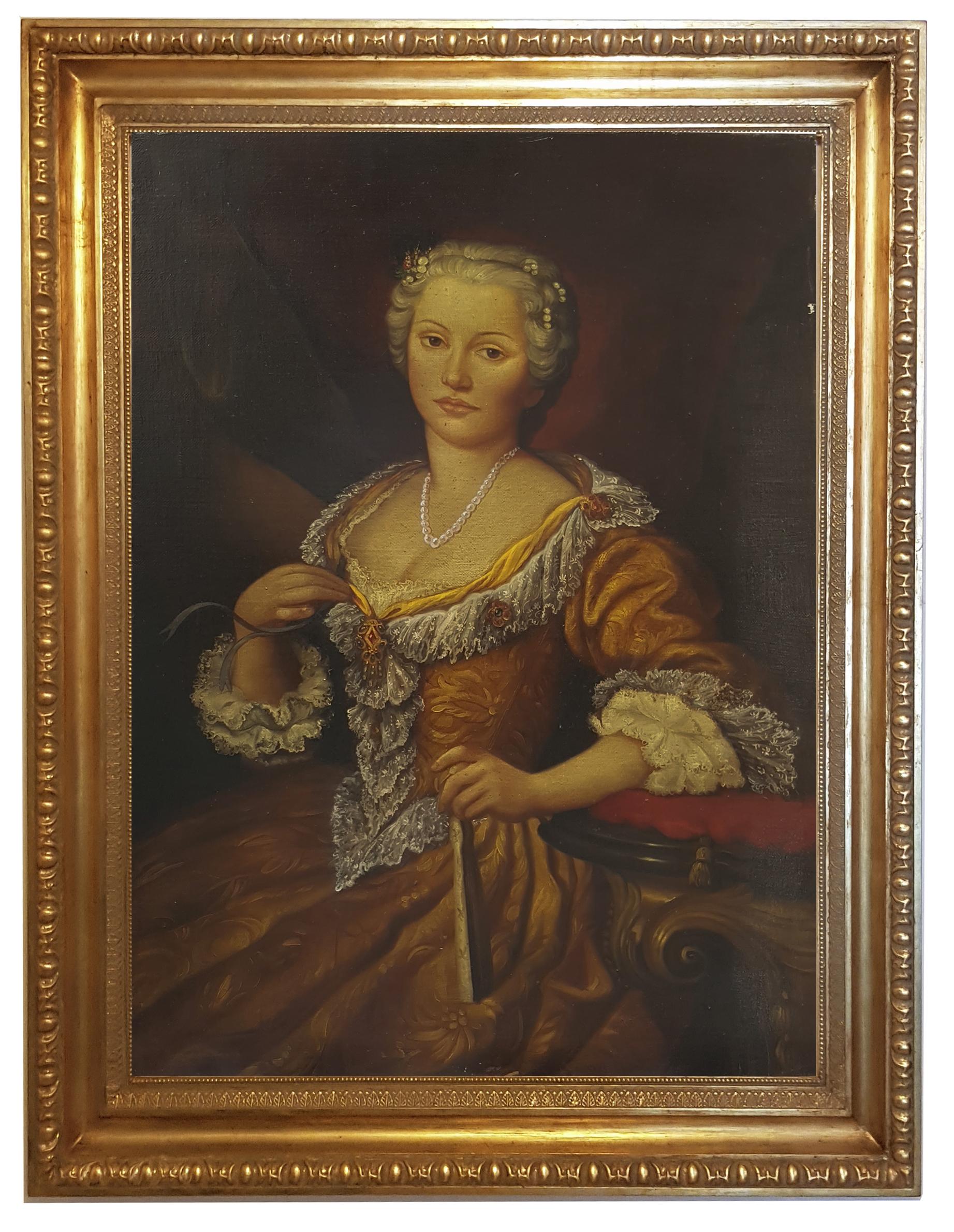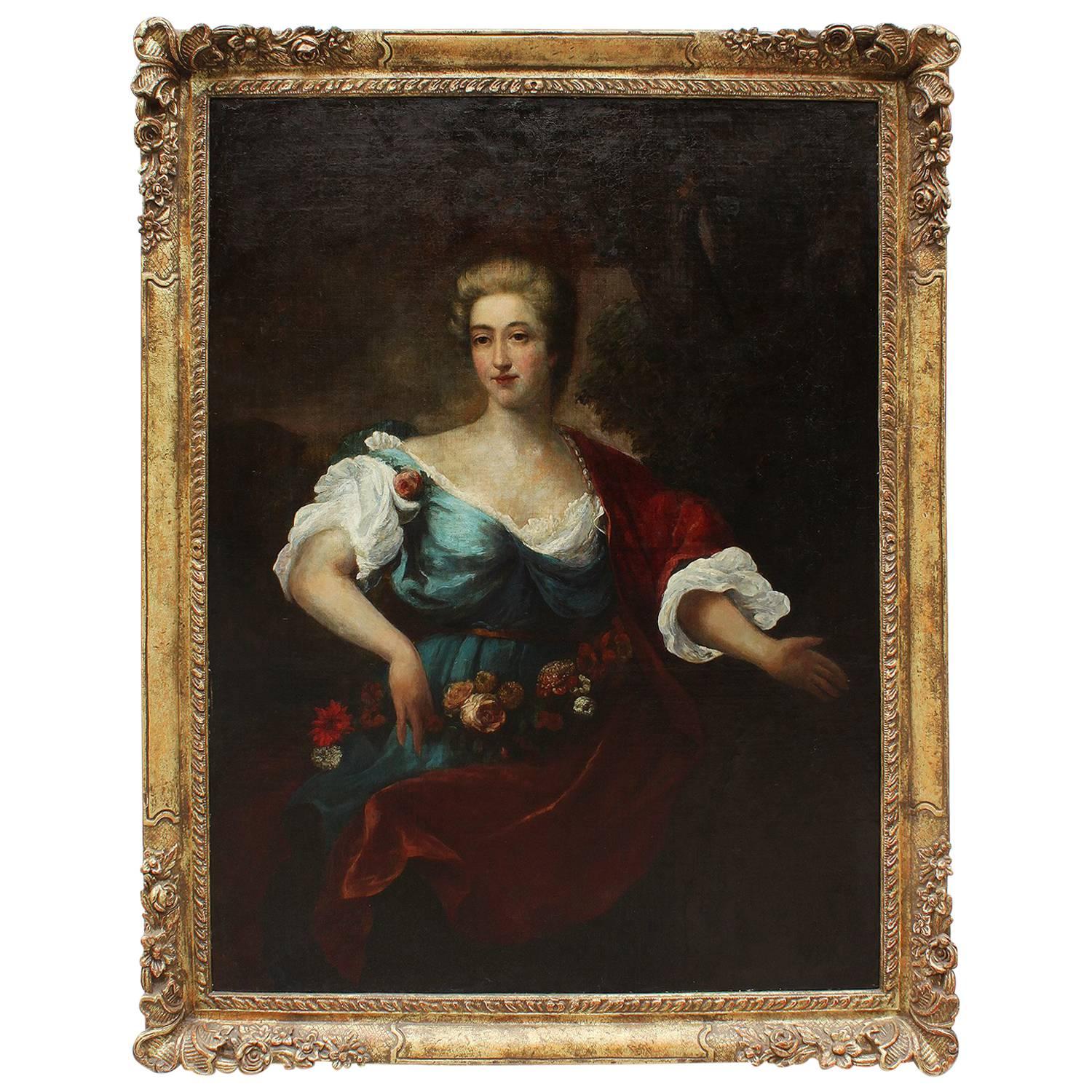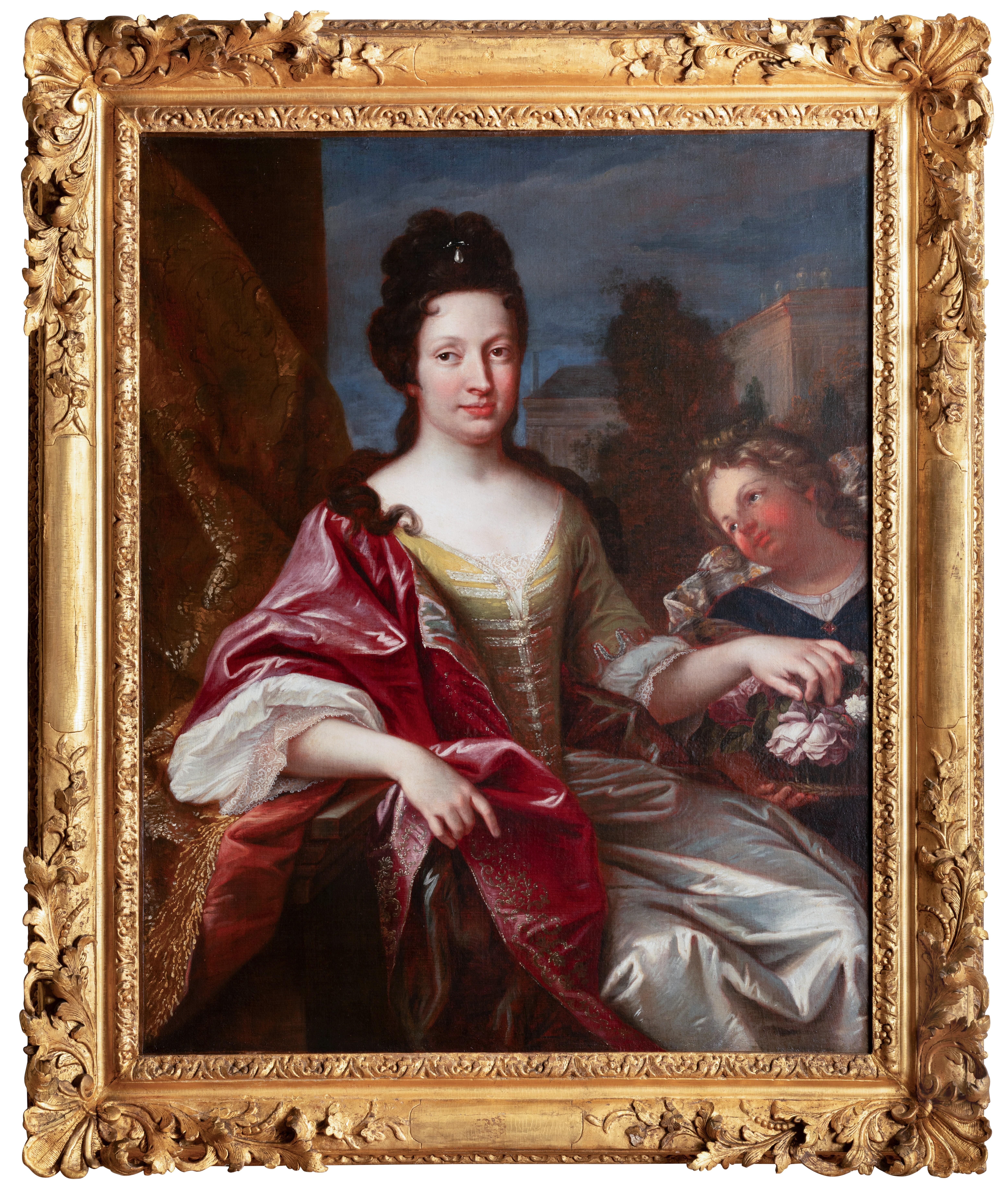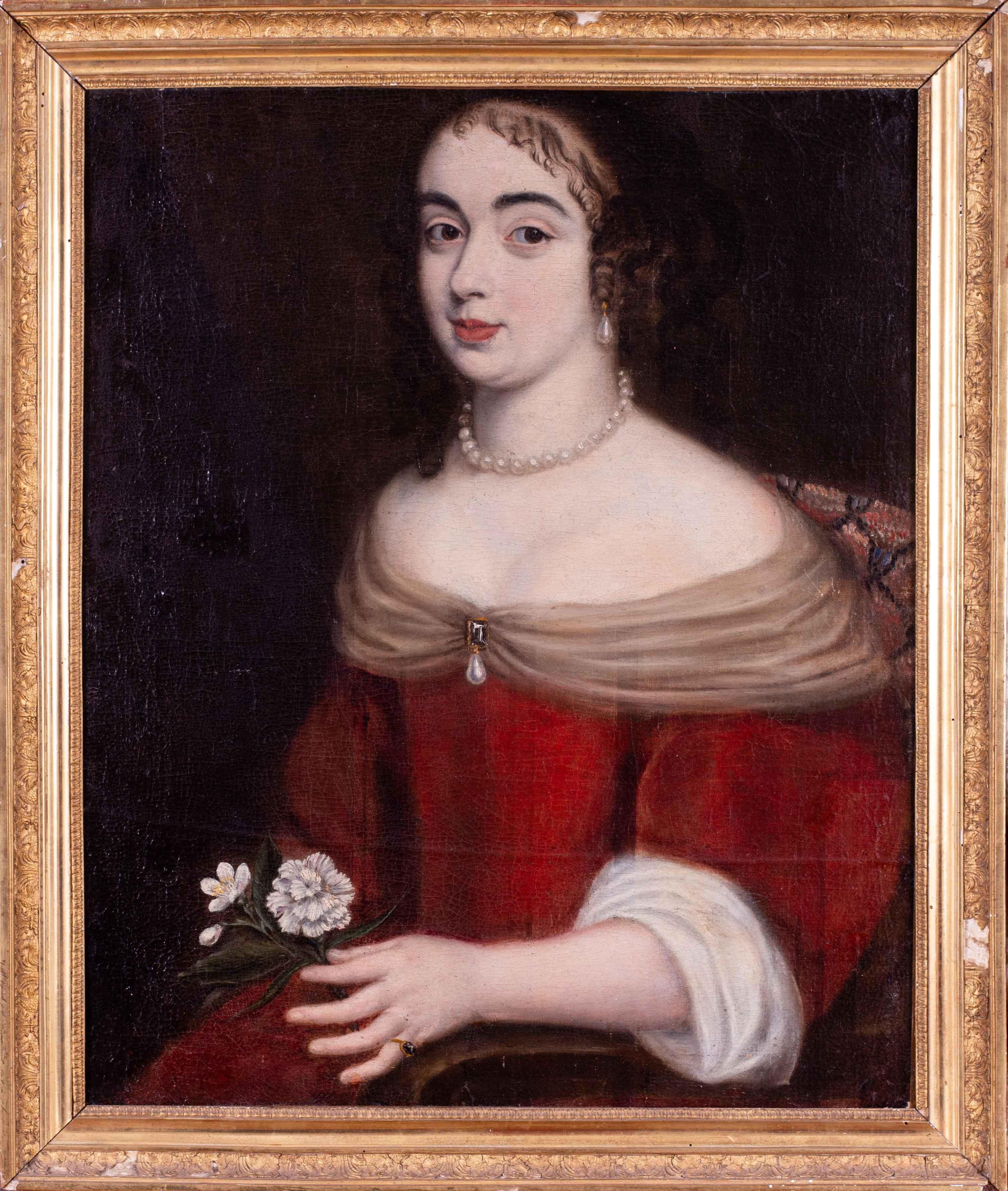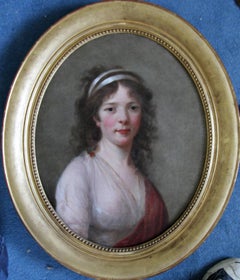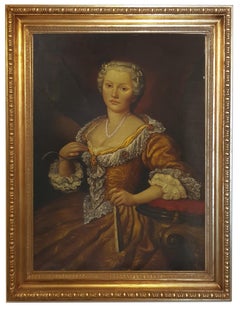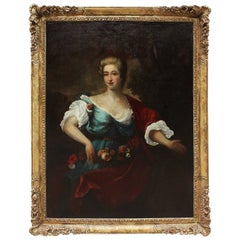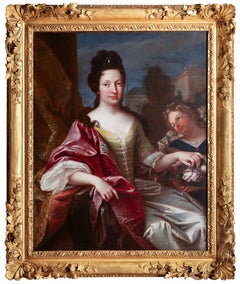Items Similar to Portrait of Maria Vittoria Queen of Portugal - Italian Old Master oil painting
Want more images or videos?
Request additional images or videos from the seller
1 of 17
Domenico Maria SaniPortrait of Maria Vittoria Queen of Portugal - Italian Old Master oil paintingCirca 1732
Circa 1732
$37,295.39
$46,619.2320% Off
£27,200
£34,00020% Off
€31,722.78
€39,653.4820% Off
CA$51,070.14
CA$63,837.6720% Off
A$56,783.04
A$70,978.8120% Off
CHF 29,648.97
CHF 37,061.2220% Off
MX$691,187.92
MX$863,984.9020% Off
NOK 378,307.98
NOK 472,884.9820% Off
SEK 354,456.50
SEK 443,070.6320% Off
DKK 236,752.97
DKK 295,941.2220% Off
Shipping
Retrieving quote...The 1stDibs Promise:
Authenticity Guarantee,
Money-Back Guarantee,
24-Hour Cancellation
About the Item
This lovely Italian Old Master portrait oil painting is by Domenico Maria Sani. Painted circa 1732 the sitter is of Maria Anna Vittoria (1718 - 1788), daughter of Philip V and Elisabetta Farnese, who in 1729 married Joseph prince of Brazil and king of Portugal, becoming Queen of Portugal by marriage. The painting is a variant by the artist of another full-length portrait of the sovereign executed by Domenico Maria Sani in the Royal Palace of Riofrio, identified in archival documents and inventories as "Portrait of dona Mariana Victoria". Maria Anna Vittoria is portrayed in three-quarter length. She wears a sumptuous blue satin dress adorned with a wealth of embroidery and applications of precious stones, with pearl drop decorations; they harmonize with the hairstyle, from which hangs a long lock of hair resting softly on her shoulder. The sovereign is then covered by an orange cloak that leaves her left side completely uncovered. With her right hand she delicately places a carnation in a rich floral arrangement placed on a piece of furniture. A really stunning Italian Old Master portrait oil painting of Portuguese royalty.
Mariana Victoria of Spain (Portuguese: Mariana Vitória; 31 March 1718 – 15 January 1781) was an Infanta of Spain by birth and was later the Queen of Portugal as wife of King Joseph I. The eldest daughter of Philip V of Spain and Elisabeth Farnese, she was engaged to the young Louis XV of France at the age of seven. Rejected due to her age, the marriage never took place and she was sent back to Spain. In 1729 she was married to Infante José, son of John V of Portugal and successor to his father as Joseph I of Portugal. She also acted as regent of Portugal during the last months of her husband's life and as advisor to her daughter, Maria I of Portugal, in her reign.
Provenance. Royal Palace of Caserta, via Douhet, 2, Caserta (CE), Campania - Italy - picture gallery VIII room: portraiture of the 700 and 800, inv. 1092 (1977/1978)
Condition. Oil on canvas, 41 inches by 32 inches and in good clean condition.
Frame. Housed in a carved gilt frame, 48 inches by 39 inches and in good condition.
Domenico Maria Sani (1690-1773). Italian painter and designer, trained in Andrea Procaccini's workshop in Rome. In 1721 he moved to Madrid, claimed by his teacher who had arrived in Spain a year earlier. There he worked until his death on decorative projects for the palace of La Granja, also making portrait paintings and cardboard for tapestries. His work as Procaccini's assistant focused on the various decorative tasks of the aforementioned palace, such as the marble and jasper cabinet and the painting of the new gallery. In Madrid he began his work in the Royal Tapestry Factory of Santa Bárbara in 1731, and the following year he painted several portraits of members of the royal family, including that of Isabel de Farnesio, who granted him various positions in the royal bureaucracy. He was appointed painter to the king and gave drawing classes to the prince of Asturias, the future Fernando VI, until occupying the post of roomer.
Hardly any examples of his activity as a decorator painter have come down to us, but we know the altarpieces made by order of Isabel de Farnesio in 1759 -year in which the Academy of San Fernando granted him the title of honorary director of painting- for the altars of La Farm.
Of his portrait work the effigies of the queen are not preserved, but that of the Infanta María Ana Victoria is attributed to him, where the influence of his teacher Procaccini is added to that of Jean Ranc, official painter of the kings.
- Creator:Domenico Maria Sani (1690 - 1773, Italian)
- Creation Year:Circa 1732
- Dimensions:Height: 48 in (121.92 cm)Width: 39 in (99.06 cm)Depth: 2 in (5.08 cm)
- Medium:
- Movement & Style:
- Period:
- Condition:
- Gallery Location:London, GB
- Reference Number:1stDibs: LU853113060982
About the Seller
5.0
Platinum Seller
Premium sellers with a 4.7+ rating and 24-hour response times
1stDibs seller since 2018
454 sales on 1stDibs
Typical response time: 1 hour
- ShippingRetrieving quote...Shipping from: London, United Kingdom
- Return Policy
Authenticity Guarantee
In the unlikely event there’s an issue with an item’s authenticity, contact us within 1 year for a full refund. DetailsMoney-Back Guarantee
If your item is not as described, is damaged in transit, or does not arrive, contact us within 7 days for a full refund. Details24-Hour Cancellation
You have a 24-hour grace period in which to reconsider your purchase, with no questions asked.Vetted Professional Sellers
Our world-class sellers must adhere to strict standards for service and quality, maintaining the integrity of our listings.Price-Match Guarantee
If you find that a seller listed the same item for a lower price elsewhere, we’ll match it.Trusted Global Delivery
Our best-in-class carrier network provides specialized shipping options worldwide, including custom delivery.More From This Seller
View AllPortrait of Anna de Hooghe - Flemish art Old Master portrait oil painting
By Jacob Ferdinand Voet 1
Located in London, GB
This strong Flemish Old Master portrait oil painting is attributed to Ferdinand Voet. The sitter is Anna De Hooghe, the fourth wife of artist Ludolf Bakhuizen (1631-1708), a German-born Dutch painter, draughtsman, calligrapher and printmaker. He was the leading Dutch painter of maritime subjects after Willem van de Velde the Elder and Younger left for England in 1672. He also painted portraits of his family and circle of friends. Painted circa 1660 Anna is standing profile but turned to the viewer/artist with her hand to her heart. She is set in a landscape at twilight. A really lovely painting and superb example of Dutch art. It is recorded in the RKD archives with N Maes signature LL - since removed through restoration.
Provenance. The estate of George Way.
Archive RKD
Condition. Oil on canvas, 38 inches by 34 inches unframed and in good condition.
Frame. Housed in a fine period carved frame, 46 inches by 42 inches framed and in good condition.
Jacob Ferdinand Voet or Jakob Ferdinand Voet (1639-1689) was a Flemish portrait...
Category
17th Century Old Masters Portrait Paintings
Materials
Oil
$15,356 Sale Price
20% Off
Portrait of a Lady - British 17th century art Old Master portrait oil painting
Located in London, GB
This lovely British Old Master portrait oil painting is by noted British Old Master artist James Cranke. Cranke taught George Romney to paint as a small boy, living near by. Painted ...
Category
17th Century Old Masters Portrait Paintings
Materials
Oil
Portrait of Frances Howard Duchess of Richmond - Flemish Old Master oil painting
By Anthony van Dyck
Located in London, GB
This stunning Flemish Old Master portrait oil painting is attributed to circle of Anthony Van Dyck. Painted circa 1630, the sitter is Frances Stewart née Howard (1578 -1639) Duchess ...
Category
Early 17th Century Old Masters Portrait Paintings
Materials
Oil
$52,652 Sale Price
20% Off
Portrait of Madam van Robais - French Old Master oil painting 18th century art
Located in London, GB
This fine French Old Master portrait oil painting on canvas dates to circa 1770 and is attributed to the circle of Elizabeth Vigee Le Brun. The sitter is Madam van Robais.
The van R...
Category
18th Century Old Masters Portrait Paintings
Materials
Oil
$20,293 Sale Price
20% Off
Portrait of Mrs Harborough - British 18th century art portrait lady oil painting
Located in London, GB
This lovely 18th century Old Master portrait oil painting is attributed to the circle of noted portrait artist Enoch Seeman. Seeman came from Poland to England as a youngster with hi...
Category
18th Century Old Masters Portrait Paintings
Materials
Oil
Portrait of Mrs James Hoste - British 18th century art portrait oil painting
By John Vanderbank
Located in London, GB
This superb large three quarter length British Old Master portrait in a landscape oil painting is attributed to circle of John Vanderbank the Younger. Painted circa 1738 the sitter is Mrs James Hoste of South Wootton and Sandringham, nee Hammond. She was the daughter of Anthony Hamond and Susan Walpole, daughter of Robert Walpole, and was sister to Robert, 1st Earl of Oxford. She married Major James Hoste of Sandringham, Norfolk, and they had two daughters. The sheen of her blue satin dress against her gold cloak is stunning. A really lovely 18th century portrait with excellent provenance.
Inscribed with sitter details lower left.
Provenance. By descent within the family of the sitter at West Acre High House, Norfolk;
Cheffins, Cambridge, 'West Acre High House' sale, 24 November 2010, Lot 519; Wood Hall, Arkesden, Essex.
Literature: 'Portraits in Norfolk Houses', Prince Duleep Singh, 1927, No. 36.
Sitter's details on two labels verso.
Condition. Oil on canvas, image size is 50 inches by 40 inches and in good condition.
Frame. Housed in an ornate gilt frame, 58 inches by 48 inches framed and in good condition.
John Vanderbank (1694-1739) was an English portraitist and book illustrator, who enjoyed a high reputation for a short while during the reign of King George...
Category
18th Century Old Masters Portrait Paintings
Materials
Oil
$13,163 Sale Price
20% Off
You May Also Like
PORTRAIT OF A LADY E.Frattini - English School - Italy Figurative Oil on Canvas
By Ettore Frattini
Located in Napoli, IT
Portrait of a Lady - Ettore Frattini Italia 2005 - Oil on canvas cm.100x70.
The painting by Ettore Frattini depicts an elegant and refined noblewoman, the painting is inspired by t...
Category
Early 2000s Baroque Portrait Paintings
Materials
Canvas, Oil
French 18th-19th Century Oil on Canvas Portrait of Lady, after Jean-Marc Nattier
By Jean-Marc Nattier
Located in Los Angeles, CA
A very fine French 18th-19th century oil on canvas portrait of a posing lady with flowers, after Jean-Marc Nattier (1685-1766) within an ornate gilt wood carved frame, circa 1800.
...
Category
Antique Early 19th Century French Louis XV Paintings
Materials
Canvas, Giltwood
$11,960 Sale Price
20% Off
Portrait of the French Princess, late 17th c. French school
Located in PARIS, FR
Portrait of the Princess of Conti - Attributed to Louis Ferdinand Elle the Younger (1648-1717)
Late 17th century French school
Oil on canvas, h. 100 cm, l. 80 cm
Important Louis XIV ...
Category
Late 17th Century Old Masters Portrait Paintings
Materials
Canvas, Oil
Portrait Marianne Cogny De Troy Paint Oil on canvas 17/18th Century Old master
Located in Riva del Garda, IT
Workshop/Circle of François de Troy (Toulouse 1645 – Paris 1730)
Portrait of a young lady (probably Marianne de Cogny, epouse de Philippe-Emmanuel de Beaufort...
Category
18th Century Old Masters Paintings
Materials
Oil
$9,461 Sale Price
20% Off
French School, 17th Century, 'Portrait of the Marquise de Grugieres', oil canvas
Located in Petworth, West Sussex
French school, 17th Century
Portrait of the Marquise de Grugieres
Oil on canvas
26.1/4 x 21.5/8 in. (66.7 x 54.8 cm.)
In a gilded composite frame, later production (possible early 1...
Category
17th Century Old Masters Portrait Paintings
Materials
Canvas, Oil
Portrait of D. Maria Bárbara De Bragança, Circle of Louis-Michel Van Loo
By H. van Loon
Located in Lisboa, PT
PORTRAIT OF D. MARIA BÁRBARA DE BRAGANÇA (1711-1758), QUEEN OF SPAIN
Circle of Louis-Michel van Loo (1707-1771)
Oil on canvas
Her Royal Highness, the Infanta Maria Barbara of Braganza (1711-1758) was the first-born child of King John V of Portugal (1689-1750) and his queen consort Maria Anna of Austria (1683-1754). Born in December 1711, she had the Convent Palace of Mafra built in her honour following a vow made by her royal father. Her status as Princess of Brazil, inherent to 18th century Portuguese presumptive heirs, would however be superseded once the queen gave birth to two male princes, D. Pedro (1712-1714) and D. José (1714-1777), preventing her from ascending to the throne.
Daughter of one of the most illustrious monarchs of his time, Maria Barbara was carefully educated to become a fond admirer of the arts, and of music in particular, having had the Italian composer Domenico Scarlatti (1685-1757) as her music teacher.
On the 10th January 1723 the young princess was betrothed to the Infante Ferdinand of Spain (1713-1759), eldest son of King Philip V (1683-1746). Six years later, on the 19th January, she entered her new country in a carefully choreographed ceremony that became known to history as the “Exchange of the Princesses”. This unique event took place on a specially built Bridge-Palace, a wooden, luxuriously decorated structure that included various modules and rooms, on both banks of the river Caia, the natural border between the town of Elvas in Portugal and of Badajoz in Spain. Simultaneously, on the same day that the Portuguese Infanta crossed the border to marry the Spanish Crown Prince, her new sister in law, the Infanta Mariana Victoria of Bourbon (1718-1781), her husband’s sister, crossed the same bridge in the opposite direction to marry Prince D. José, the Portuguese heir to the throne.
Once married, Maria Barbara would spend 17 years as Princess of Asturias, only becoming Queen of Spain at her husband’s accession following the death of Philip V in 1746. She is portrayed in the 1743 painting by Louis-Michel van Loo (1707-1771) now in the Prado Museum, in which Philip V had himself represented with all his close family.
The new Queen would take an important role at court eventually becoming the liaison between her husband and the King of Portugal, particularly throughout the negotiations for the Treaty of Madrid (1746-1750). Maintaining her interest in music, she patronized the Italian castrato singer Farinelli (1705-1782) while remaining close to her old master Scarlatti, having herself composed some sonatas for a large orchestra. She would also commission and fund the building of the Royal Salesians Monastery complex in central Madrid, where both her and Ferdinand VI are buried.
The portrait we are presenting for sale shows the Queen in half-length, turning left at three quarters. She is wearing a blue low-cut dress embroidered with flowers and foliage, over a lace cuffed white blouse, and an ermine cloak pined on the left-hand side by a diamond broach. The powdered hair style is held sideways by a seven diamond and black plume headdress and topped by a small gold and pearl crown. The right arm rests on a cushion while the left hand, at chest height, holds a miniature male portrait.
The Infanta’s features are analogous to the 1725 portrait by the painter Domenico Duprà (1689-1770), also in the Prado Museum collection. Further similarities can be found in another portrait by Louis-Michel van Loo, in which a seven diamond and black plume headdress is also present. In this work, the cushion supporting Maria Barbara’s right arm has also some obvious similarities to our painting. The same diamond headdress reappears in Van Loo’s above-mentioned portrait of Philip V’s family dated from 1743.
It is nevertheless in Lisbon’s Ajuda National Palace that it is possible to find an almost identical depiction of the Infanta holding a miniature portrait of her husband. In it, the future Ferdinand VI is portrayed facing right at three quarters and wearing a curly wig, suit of armour, the golden fleece insignia and a blue band, in a composition that closely resembles an 18th century Spanish school painting that appeared in the art market in January 2016.
Another detail common to various portraits of the Portuguese Infanta and Queen of Spain is the small gold and pearl crown on her head. In another Van Loo painting, also from the Prado Museum, in which Maria Barbara is portrayed as Queen, this crown is represented together with a headdress similar to the one previously described. Another two paintings by the same artist, at the Royal Academy of Saint Ferdinand, include the same ornament.
We must also refer the paintings by the artist Jean Ranc (1674-1735). In one, dating from 1729 (Prado Museum), the Infanta is depicted outdoors holding a flower bouquet and wearing a yellow silk dress with red cloak, and a set of diamond and ruby jewellery that includes a headdress similar to the one present in our portrait. Another work by the same artist, belonging to the Complutence University of Madrid, depicts the Infanta sumptuously dressed in identical colours to our painting and wearing an elaborate headdress and diadem.
These portraits, beyond their iconographical importance as contemporary records of the Infanta and Queen Maria Barbara, are also illustrative of 18th century fashion for jewelled head dressing. Often, flowers were combined with joyful adornments, composing almost theatrical displays that would reinforce the ostentatious nature of the image. The ornamental flowers and the chromatic character of the jewels would complement the luxury of the colourful dresses in blue, crimson, green or other silk shades, in compositions whose sole purpose was to highlight a royal sitter’s wealth and power, becoming an essential statement accessory within the strict court protocols and codes of conduct.
Circle of Louis-Michel van Loo (1707-1771)
Slowly but steadily, the resolute, tranquil and dignified attitude of Renaissance and Baroque portraiture becomes artificial and presumptuous. Mid 18th century society favours elusive expression and psychological deepness, albeit limited to the face, that, with emphasis on detail, on the rich colour palette and on changing costumes and landscapes, associated to the courtliness of gestures, creates a strongly artificial environment while maintaining a highly poetic intrinsic character.
Louis-Michel van Loo followed a dynasty of famous Dutch origin artists that had settled in France. Initially taught by his father, Jean-Baptiste von Loo (1684-1745), the younger van Loo studied in Turin and Rome and frequented the Paris Academy. In Rome he worked with his uncle Charles-André van Loo (1705-1765) and become a painter for the Turin Court. In 1737 he arrived in Spain being summoned by Philip V to succeed Jean Ranc as painter of the king’s chamber.
In Madrid, his work covers the numerous Court commissions and the Royal Saint Ferdinand Fine Arts Academy, of which he was a founding member and director for the Painting department in 1752. Is production at court consisted essentially of numerous portrait paintings, often Royal gifts...
Category
Antique 18th Century Spanish Baroque Paintings
Materials
Canvas
More Ways To Browse
Old Factory
Queen Of France
Brazilian Antique Art
Spain Old Masters
Portuguese Mid Century Art
French Quarter Painting
Portrait Portugal
Queen Dress
Antique Carnation
Floral Paintings 18th Century
Hand Embroidery Italian
Used Furniture Santa Maria
Floral Old Masters
Antique Sovereigns
Full Length Portrait Oil Painting
Prince Philip
Brazil Tapestry
Philip Stone
